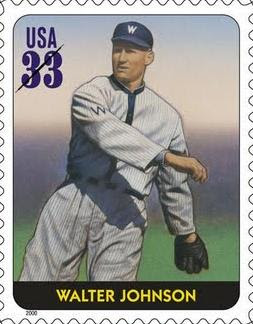
Robert Moses "Lefty" Grove (March 6, 1900 – May 22, 1975) was a professional baseball pitcher. After having success in the minor leagues during the early 1920s, Grove became a star in Major League Baseball with the American League's Philadelphia Athletics and Boston Red Sox, winning 300 games in his 17-year MLB career. He was elected to the National Baseball Hall of Fame in 1947.
One of the greatest left-handed pitchers in major league history, Grove led the American League in wins in four separate seasons, in strikeouts seven years in a row, and had the league's lowest earned run average a record nine times. Over the course of the three years from 1929 to 1931 he twice won the pitcher's Triple Crown, leading the league in wins, strikeouts, and ERA, while amassing a 79-15 record as the ace for the Athletics' dynasty teams.
Born in Lonaconing, Maryland, Grove was a sandlot star in the Baltimore area during the 1910s. In 1920, he made his professional debut with the Martinsburg Mountaineers of the class-D Blue Ridge League, where he appeared in six games. In 59 innings pitched, Grove gave up just 30 hits, and he had an earned run average (ERA) of 1.68. His performance attracted the attention of Jack Dunn, the owner of the minor league Baltimore Orioles, who also discovered Babe Ruth.

Hall of Fame Major League Baseball Player. Played 17 seasons with the Philadelphia Athletics and the Boston Red Sox. One of the premier Left Handed Pitchers of the 20th Century, and the dominant pitcher of the late 20s and early 30s. Came to the Majors in 1925 with the A's, posting a 10 and 12 record and leading the American League in strikeouts (116). Went on to lead the League in strikeouts for his first seven seasons. Starred with the A's from 1925 to 1933, winning 20 or more games seven years in a row. Led the American League in wins in 1928 (24), 1930 (28), 1931 (31) and 1933 (24). Led the AL in ERA 5 times in his first 8 seasons, and accomplished Pitching's Triples Crown (Most Wins, Most Strikeouts and Lowest ERA) two years in a row (1930, 1931). Led the A's to 3 successive World Series (1929, 1930 and 1931). In 1929 his A's beat the Cubs 4 games to 1. In 1930 he won two games (and lost one) as the A's beat the Cardinals 4 games to 2. In 1931 he again won two games and lost one, but the Gas House Gang Cardinals beat his A's 4 games to 3. His Regular Season record during those three years was a staggering 79 wins and 15 losses. In 1931 he won 16 games in a row, and just missed wining his 17th when the A's lost 1-0. In 1934 he was sold to the Boston Red Sox, with whom he had one 20 win season and lead the AL in ERA 4 times. His career total came to 300 wins, 141 losses. He appeared in 6 All-Star teams (1 with the A's, 5 with the Red Sox), pitching in the very first Game in 1933, and was the losing pitcher for the AL in the 1936 game. Led the AL in ERA for 9 of his 17 seasons. He was an intense competitor, and was known for vicious tirades and attacks against teammates who he thought were not playing hard enough. Inducted into the Baseball Hall of Fame in 1947

Grove retired in 1941 with a career record of 300-141. His .680 lifetime winning percentage is eighth all-time;however, none of the seven men ahead of him won more than 236 games. His lifetime ERA of 3.06, when normalized to overall league ERA and adjusted for the parks in which Grove played during his career, is fourth all-time among pitchers with at least 1,000 innings pitched (behind Mariano Rivera, Jim Devlin, and Pedro Martínez) at 48 percent better than average.
Grove was elected to the National Baseball Hall of Fame in 1947. He died in Norwalk, Ohio and was interred in the Frostburg Memorial Cemetery in Frostburg, Maryland.
In 1998, Grove was ranked number 23 on The Sporting News list of Baseball's Greatest Players.He ranked second, behind only Warren Spahn, among left-handed pitchers (third when Babe Ruth is counted as a pitcher as well as an outfielder). That same year, Grove was elected to the Major League Baseball All-Century Team.











